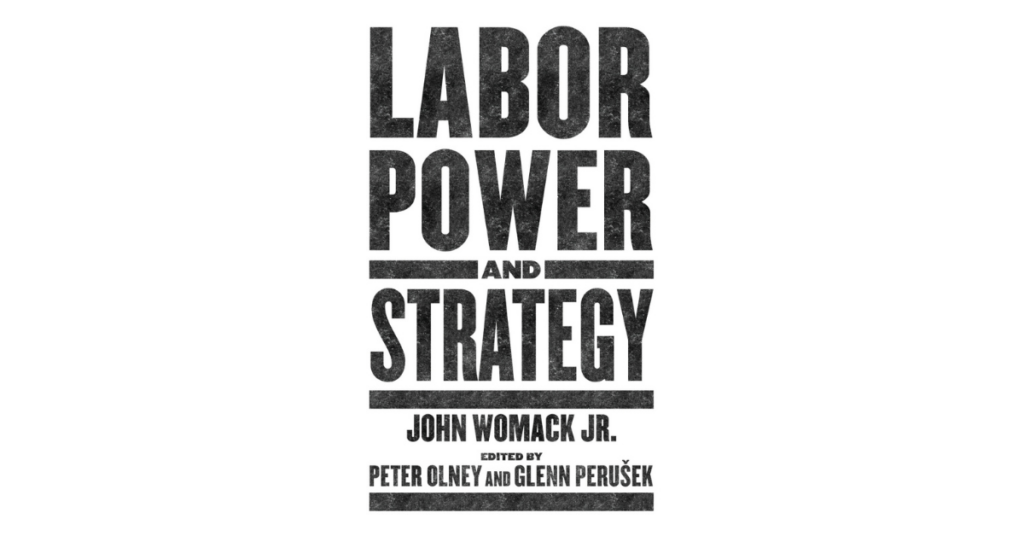
Workers in choke points in the economy and critical functions within an industry, labeled “technically strategic” workers, sit at the center of historian John Womack Jr.’s “Foundry Interviews.” These make up the core of Labor Power and Strategy, a short volume recently published by PM Press.
For Womack the idea that technically strategic workers are key to the labor movement comes from the ability to interrupt and disrupt the normal flow of the economy. The idea of supply chains and networks stand, for obvious reasons, at the core of these ideas. Organizing around logistical and technical “choke points” is not a new idea, but Womack takes it a few steps further.
It is telling that the interviews happened shortly after the 2018 teacher strikes. Womack and his interviewer, Peter Olney, integrate reproductive care workers into their map of strategically critical workers. They emphasize the ability of the West Virginia teachers to shut down most of the state’s economy. Later in the book he extends this to the essential workers revealed in the COVID-19 pandemic.
Womack also looks at workers pushed into sections of the economy without regular employment. He considers this “precariat” a significant part of the working class. The IWW’s Agricultural Workers Organization is offered as a model for organizing this sector. Unfortunately this type of organizing is not discussed further through the book.
Another major problem brought up by Womack is the difficulty of avoiding sectional disputes when organizing strategically privileged workers. Womack tries to resolve this through class consciousness, education, and moral comradeship. The idea of “one big union” to unite the working class never enters the conversation.
The “Foundry Interviews” are followed by a series of replies by a variety of labor writers and organizers, and a final rejoinder by Womack. (I’ve skipped a few to focus on the most interesting points.) Bill Fletcher, Jr. makes a pointed rejoinder, “Should Spartacus Have Organized the Roman Citizenry Rather than the Slaves?” In place of Womack’s focus on strategic workers, he centers the most oppressed elements of the working class. He also notes the strategic role of race and gender within labor organizing.
Katy Fox-Hodess, a researcher whose work has focused on dockworkers, says in “No Magic Bullet” that the technically strategic workers Womack wishes to focus on need to build alliances with workers in other sectors and through their communities. Jack Metzgar has a similar comment where he defends Erik Olin Wright’s idea of “associational power” within classes. Both emphasize that Womack’s focus is one-sided.
Jane McAlevey, the foremost thinker on organizing from business unions, intervenes with a partial defense of Womack’s ideas. She also emphasizes the role of women in public sector work as a critical vector of organization.
Melissa Shetler points to the role of Paolo Freire’s methods of pedagogy within union organizing. “Abandon the Banking Method” is a useful suggestion for any training work. (Of course the AFL-CIO methods are never compared to the IWW’s Organizer Training.) And the last of the responses is by Gene Bruskin, director of organizing with the United Food and Commercial Workers (UFCW). Bruskin’s account is a fascinating description of building power in a majority-immigrant meat processing plant, but of course ends with its climax in the vote to make the UFCW the official bargaining agent.
Womack’s response returns his focus to the technically strategic workers. He reiterates their importance while acknowledging when others have made solid points. He also has the advantage of having written the reply after the COVID-19 pandemic began, giving it the ability to comment on the “great resignation” and “essential workers” of the last few years.
It is welcome to see a book that looks at labor power with a horizon beyond capitalism. It provides a welcome basis for strategy and is worth reading for anyone doing organizing among workers. There are also several sharp comments on campaigns that merit reading. These include the fast food organizing efforts and a failed United Auto Workers campaign in Mississippi.
Womack and his respondents do not look beyond the organizing strategies of the business unions. This is especially a problem in the discussion of narrow sectional interests, where these limitations are seen in their sharpest relief. It is unfortunate that no solidarity union perspective is offered. Class solidarity requires unity in the labor movement and with the community. It is unclear what role direct action can play in this strategic view. Aside from a few mentions of hacking it goes unmentioned. This is disappointing in a book from PM Press with an advertisement for Staughton Lynd’s Solidarity Unionism at its end.
Labor Power and Strategy is available for sale in the IWW store.
Contact the IWW today if you want to start organizing at your job.
If you are a member in good standing and wish to take the Organizer Training 101, please email the OTC. If you would like to request a group OT101 with your GMB, job branch, or coworkers, fill out this form.
